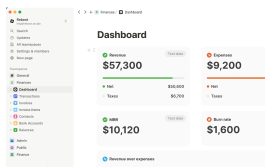For decades, businesses have seen the benefits of paying employees on commission. Salespeople tend to perform better when they know a win for the store is a win for their own pockets, too. But what’s the best commission payment system, and how can you manage it effectively?
Maybe you’re just getting started, hoping to set up a commission payment system right from the start. Maybe you opened your store a few years ago, and now managing commissions for those employees has turned into an Excel spreadsheet nightmare of constantly updated product bundles, plan changes, and accounting headaches. Either way, we’re here to help.
This post walks through the basics of setting up a commission payment system. We’ll discuss the types of commission structures, provide some expert tips, and then discuss three software solutions you can explore to manage your payment structure efficiently.
Elements of a Commission Payment System
Let’s start with the basics: What is a commission payment system? A commission payment system is a payment plan that compensates staff through performance-based pay, incentivizing productivity.
Commission payment systems are most often seen in sales-driven businesses. Customized commission structures award top talent whose results align with company growth and profitability goals. When you’re setting up a commission system for your business, you must consider several factors:
- Commission Structure
First, you need to set up a commission structure with defined commission rates and tiered structures. Your commission format sets earning potential, motivating your staff to achieve preset targets. Some common options include percentage-based commission per sale or progressive rates based on targets met. - Performance Metrics and Tracking
Detailed analytics and reporting provide visibility to employers and employees around progress toward commission goals. Tracking key performance indicators (KPIs) allows employees to track their progress and drives accountability from employers, ensuring everyone is on the same page regarding performance and earning potential. - Payment Calculations
You must set up a system for accurate and timely calculations and payments for your staff. Commission earnings should be calculated automatically based on verified performance data. You should integrate this capability with your payroll system, ensuring all earnings are taxed properly and paid out promptly. - Transparent Policies
Unclear commission policies can result in mistrust and frustration rather than motivation for your staff. Instead, maintain open communication around goal updates, payout timelines, targets, and more. A transparent commission structure and clear tracking sets your commission payment system up for success. - Feedback and Motivation
Finally, your commission system should be about more than money. You can use the data gleaned from your commission payment system to guide performance reviews and incentives for your team. Sincere acknowledgment of achievements and constructive feedback on improvement areas can help drive a high-performance culture in your store.
Well-designed commission systems boost productivity by financially rewarding top talent. Balanced compensation formats, automation support, strong communication, and meaningful recognition empower consistent success motivated by commission potential. Let’s now dive into the details of how you can create an optimal commission structure for your business.
Related Read: Your Point of Sale Data Is a Goldmine. Here's How Yo Make the Most of It
Types of Sales Compensation Structures
You can choose from several different options when setting up payment systems for your business. Let’s examine some of the most common compensation structures a store like yours might consider for its salespeople.
Related Read: What Percentage of Revenue Should Be Spent on Payroll?
- Salary Only:
-
- Employees receive a fixed monetary amount on a regular basis, usually weekly, bi-weekly, or monthly, regardless of their sales performance.
- Example: A retail associate at a mobile phone store receives a fixed monthly salary of $3,000, regardless of whether they meet or exceed their sales targets.
- Commission Only:
-
- Employees earn compensation solely based on the sales they generate. There's no fixed salary or base pay involved; their earnings depend entirely on their sales performance.
- Example: A sales representative in a mobile phone store earns a five percent commission on every phone sale. They earn $50 for selling a phone priced at $1,000.
- Salary Plus Commission:
-
- Employees receive a fixed base salary along with additional earnings based on their sales performance. This structure combines guaranteed base pay with incentives tied to sales achievements.
- Example: A sales manager in a mobile phone store earns a base salary of $3,000 per month and an additional three percent commission on total store sales beyond a certain threshold. For instance, if the store exceeds $100,000 in monthly sales, the manager earns an extra commission on the surplus.
- Tiered Commission:
-
- Employees receive different commission rates based on predefined sales tiers or levels. As sales increase, the commission rate also increases accordingly.
- Example: A salesperson's commission structure might include different tiers based on monthly sales targets. They earn a five percent commission for sales up to $5,000, seven percent for sales between $5,001 and $10,000, and ten percent for sales exceeding $10,000.
- Draw Against Commission:
-
- Employees receive a regular draw, which acts as an advance on future commissions. If their earned commissions surpass the draw amount, they receive the excess. However, if their commissions fall short, they owe the difference back to the employer.
- Example: A sales representative receives a monthly draw of $2,000 against their commissions. If they earn $2,500 in commissions, they receive the excess $500. But if they earn only $1,800 in commissions, they owe back $200 (the difference between the draw and earned commissions).
Commission Payment System Tips
Once you’ve selected your payment structure, you’re ready to implement your solution! But you must be prepared to manage it. Let’s examine some expert tips and tricks you can use to manage your commission payment system more effectively.
- Don’t Cap Salaries
With a commission structure, the sky's the limit! Avoid putting a lid on what your team can earn. Encouraging higher sales benefits everyone, so keep the earning potential open-ended to maximize your sales reps’ performance. - Keep Things Simple
Simplicity is key. Complex commission structures can confuse and demotivate your team. Keep it straightforward, transparent, and easy to understand. Clarity breeds confidence, and confidence breeds enthusiasm. - Encourage Friendly Competition
Healthy competition can be motivational in the sales environment. Encourage a vibe where your team pushes each other positively. A little friendly rivalry can boost motivation and drive sales.
Pro Tip: Implement a point of sale (POS) solution with an accessible dashboard that encourages competition. CellSmart POS offers a “traffic light” dashboard, showing every sales rep’s progress toward their targets, allowing everyone to see their performance and how it stacks up against their colleagues. - Make Data-Driven Decisions
Dive into your point of sale data to make decisions regarding your commission structure and business. Analyze sales trends, customer preferences, and individual performances. Let these insights guide your strategies and incentive plans for optimized results. - Connect Commission Rates to Store Goals
Remember to align commission rates and tiers with the bigger picture. When your team sees how their efforts tie into the store's success, it fuels motivation. It's a win-win for individual success and overall store growth. - Use a Sales Commission Agreement
A solid sales commission agreement ensures clarity and protects both parties. Include authorization, documentation, non-compete clauses, and signed agreements for a secure working relationship that benefits both you and your employees.
Related Read: What Is the Difference Between a W-4 and W-2?
Top Software Solutions to Manage Your Commission Payment System
Tipalti
Tipalti offers streamlined supplier payment management for e-commerce and retail companies, aiming to enhance operational efficiency and payment processes. This tool enables businesses to maintain a leading accounts payable workflow by automating invoice workflows, facilitating supplier onboarding, executing global payments, and simplifying multi-entity payables.
Key features of Tipalti include commission payments, supplier onboarding, and automated payment processing.
Pricing is available only upon request.
SalesVista
SalesVista is an all-in-one incentive and commission management platform. This solution offers rules-based automation, advanced modeling, precise calculations, and comprehensive visibility into the sales landscape. SalesVista empowers teams with informed, data-driven decisions and eliminates manual processes, bridging the gap between finance and sales.
Key features of SalesVista include performance analytics, modeling tools, and efficient distribution of compensation adjustments.
Pricing is available only upon request.
CellSmart POS
CellSmart POS' commission module empowers businesses to implement and manage various employee commission structures. Our solution allows you to customize your commission templates based on profit, quantity, and specific actions like activations or upgrades.
With tier-based commissions, payout settings, and comprehensive reporting, CellSmart POS offers flexibility and transparency. Additionally, the module includes privacy and competition management features among employees while providing detailed commission reports for a comprehensive overview of sales incentives and their impact on the business.
Unlike the other solutions on this list, CellSmart POS is also an all-in-one point of sale solution with features like SMS management for repair timelines, inventory management, and flexible payment processing.
CellSmart’s pricing is all custom-built. You can price out your ideal package with our build and price tool.
The Best Software Solution for Your Commission Payment System
The information in this post should give you a solid baseline for what you need to do to set up a commission payment system for your business. Still, operating a business with employees paid on commission can be challenging. However, with the right software solution, it doesn’t have to be.
What is the right software solution? Ideally, you can implement an all-in-one point of sale system with the features and functionality you need to manage your commission payments, process payments, track inventory, and handle customer data. If you operate a cell phone, electronics, or mobile repair shop, you may want to consider CellSmart POS.
CellSmart POS is an all-in-one point of sale solution designed specifically for cell phone and repair shops. Our solution offers features for inventory management, transactions, and customer loyalty, in addition to employee management and commission features.
Schedule a demo of CellSmart POS today to see how our solution can help you manage your business, from commissions to sales to inventory management.





